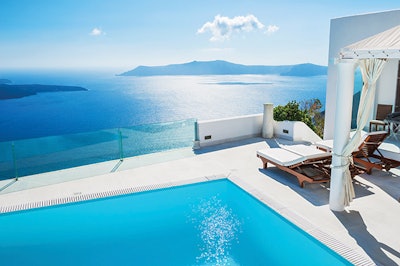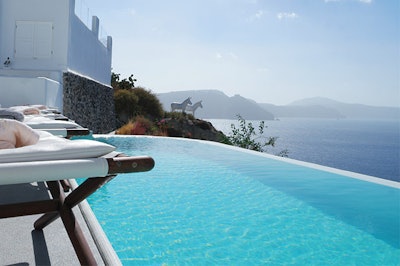
It's known as the Deutsches Institute fur Normung, or the DIN Standard, and some advocates say it's as much as 40 years ahead of the U.S.
While that might be debatable, there is no question the DIN Standard for pool water treatment is very different from the model used in the U.S.
It is a mandatory set of rules that is applied during the design, engineering and operation of all commercial/ public pools in Germany, and it influences other national standards and regulations throughout Europe.
You might think the two large, affluent western societies — the U.S. and the E.U., each with a large recreational water market, would have similar water treatment models, but in many ways, the European system is a complete departure from the traditional North American system, says Roy Vore, technology manager for Bio-Lab.
"They use much less chlorine, and the approach to filtration is completely different. They have drain-and-fill requirements and mandatory cleansing showers for bathers. It's not just one thing, but a spectrum of ideas and methods that all work together."
Do they have something to teach us about water care?
"The short answer to that question," Vore says, "is that there's a range of things we can look at that might positively influence how we treat recreational water in this country."
Perhaps the most noticeable difference is the recommended chlorine level of 0.2-to-0.6 ppm — dramatically less than the levels recommended for public pools in North America (1-to-4 ppm).
"We're talking drinking water clarity, with chlorine levels down below 0.3 ppm but with ORP of 900 millivolts,"Vore says. "For those conditions to exist, that water has to be crystal clear, because you can't get the high ORP level with that low concentration of chlorine unless you have zero organics in there or very close to it. Now, based on how we manage microbiology, you'd tend to say that's not enough chlorine. But based on the data that I've seen, in Europe their microbial levels are extremely low or even non- existent."
LESS IS MORE
"When it comes to chlorine levels," says Jody O'Grady, vice president of sales and operation and support for Taylor Technologies, "[the Europeans] have the idea that less is better."
"Part of their approach includes the use of supplementary sanitizing systems that are not as prevalent in the U.S. — and there are smaller bather loads. There are questions that still need more study because thinking in terms of achieving those low chlorine residuals is such a departure from what we do with commercial pools in the U.S."
RELATED: A New Hot Tub Manufacturer is Coming to America
The big advantages of reduced chlorine levels are well known, starting with a reduction of disinfection byproducts or DBPs. DBPs cause a range of water-quality related issues including the familiar "chlorine smell," which is largely caused by trichloramines, cloudy water and other problems such as skin, eye and lung irritation.
But in order to achieve great water quality at low chlorine levels, you must reduce the amount of organic contamination present in the water prior to chemical treatment. That approach contrasts with a North American approach of using chlorine itself to oxidize organics.
"In the U.S. we have that cliché saying, 'nuke it 'til it glows' ... that's kind of the mentality when it comes to water treatment," Vore says. "It's our traditional approach where there's a basic assumption that you're using 90% of the chlorine for oxidation,
so that means only 10% is used for sanitizing. As opposed to going for low chlorine residuals and high ORP and almost immeasurably clear water, where you don't have any organics in the water and that small amount of chlorine is available for disinfection. But you've got to remove all those organics first or it doesn't work."
FILTRATION PHILOSOPHY
The DIN Standard prescribes a number of key measures aimed at reducing organic compounds and therefore oxidizer/sanitizer demand — chief among those is a completely different approach to filtration.
Steve Ashworth is president of Pinnacle Aquatic Group, Calgary, Alberta, a company specializing in treatment systems for public pools using an approach based largely on the DIN Standard. "Many of our products do come from Europe. Our control system, our chlorination system and our filtration system comes out of Germany," he says. "The main reason is the technology and processes they use are different compared to North America. One example is the controller we use. It's a true ppm controller designed to operate at the low levels of chlorine that you would see in Europe and especially in Germany."
Ashworth's approach to treatment fits nicely with the Alberta Public Health and Compliance Pool Standard, first adopted in 2014 and amended in 2018, the first North American standard based on the DIN Standard. "It's a completely different way of doing things with a variety of specific treatment requirements, but the biggest piece of the puzzle," he says, "is the approach to filtration, which focuses on large, slow-rate, deep-bed sand filters and the mandatory use of flocculation."
Both Ashworth and Vore point to a shift in filter design back in the 1950s as the point when U.S. practices diverged from those used in Europe. "If you look back at the way we treated pools in the 1950s, in many ways the Germans are still doing it," Vore says. "We had these large slow-rate sand filters, but then in the U.S., we engineered our way into the current system and our water-quality went down."
RELATED: Environmentally Friendly In Europe
"As soon as manufacturers said that we can run at a much faster speed, that's where it all went downhill," Ashworth agrees.
"A properly sized sand filter with flocculation will work much better than a DE or cartridge ever can. You're going to operate at 10 gpm per square foot, or less. I think all filters should work at that slower rate. It gives you contact time within the freeboard to allow the flocculation to work and agglomerate the particles, which keeps them at the top of the sand bed, and it's easier to backwash. It doesn't drive the dirt into the sand bed. You also have to pay attention to your backwash speeds, so they are fast enough to create enough expansion to release the dirt."

'FLOCCING' IT
The role flocculation plays as a key component in the overall DIN Standard treatment scheme differs from its use in the U.S. where it's mainly a stopgap measure when water quality problems emerge.
In the DIN Model, pre-filter flocculation is mandatory and constantly applied. "Flocculation is an example of where the DIN Standard takes what I describe as a 'pre- approach,'" Ashworth explains. "They want to deal with the issue before it's an issue. In North America we deal with a cloudy pool rather than keeping it clear to start with. When you remove material through flocculation, you don't have to deal with it chemically. Here most people think in terms of using chemical treatment to do most of
the work, and filtration is not our first choice. But that really is like closing the gate after the horses have left.
"For the most part we use poly- aluminum chloride, PAC. You add it prefilter, where the best way to do it is to dose it, but if you do it properly, it can be hand fed, as well. The point is you're removing all those contaminants before they impact oxidizer and sanitizer demand.
O'Grady restates the case: "Whatever you can't see, make it come out of solution and physically remove it. It creates less of a demand for all of the chemicals that you're using, and it might lead to reducing the demand for higher levels of chlorine."
RELATED: Beer Spas Around the World
According to Ashworth, seeing is believing. "I was in Germany over the summer visiting an outdoor pool, and the filters were massive compared to what we see in North America, and it wasn't a large pool at all. They're giant sand filters, with deep beds and large freeboard, flocculation running on all of them. The water quality was perfect.
"All of that goes back to the idea that when you're removing all those contaminants from the water, whether it's through bather hygiene, filtration and flocculation, or draining and replacing water, you're not going to generate all those byproducts that compromise water quality," O'Grady says. "When you have a cleaner body, with a cleaner body of water, you're not going to create as much combined chlorine and that means you're probably going to have less odor, or no odor."
FRESH WATER
Another key measure defined in the DIN Standard requires that pools
be partially drained and refilled on a regular basis, based on a calculation of bather load, water volume and other variables.
"Drain and replacement is a standard equation that's used in many of the northern European countries. If you look at the pool code in Ontario, they're doing the same thing," Vore says. "It covers up a lot of sins: If you're using cal hypo, you're adding calcium. If you're using bleach, you're adding TDS. If you're using trichlor, you're adding cyanuric acid. You're adding other things into the water — it's inevitable. One way to control that is to use a standard dilution."
Ashworth agrees: "A pool or spa, or whatever kind of body of water it is, requires X-amount of freshwater per year. No matter how you get there or how you calculate it, there is an amount that you need to replace. If you're using a filter that does not backwash in a traditional sense, then you need to go to a dump-and-fill approach. If you have a sand filter that you're backwashing, that's part of your calculation. Depending on the filter, if you're using DE or some kind of replaceable media, the freshwater calculation is higher. It's typically done on a bather calculation — the busier the facility, the more freshwater you're going to add over the course of the year.
"Keep in mind," he adds, "the better filtration you have, the less amount of water you'll need to replace."
Also, the use of ozone and UV is common in DIN Standard pools but not required in all of them. "Ozone/ UV, some of them have it and some of them don't, so there are different approaches in different facilities," Vore says.
RELATED: Natural Origins: The Pursuit of a Chemical-Free Pool
Another key distinction is that DIN Standard pools all have 100% perimeter overflow systems to maximize skimming action, which is also critical in removing debris and contaminants as they enter the water.
Finally, one of the big takeaways from the DIN Standard is all about requiring bathers to take a cleansing shower before they get in a pool or spa. Although it's difficult to control such personal behavior, according to Ashworth, the value of clean humans entering the water is almost immeasurable from a water treatment standpoint.
"Showering before you get in the pool gets rid of 90% of your pool problems. It changes everything with regard to filtration and chemical treatment," he says. "In Alberta,we have a health act that requires a cleansing shower before you get in any public pool or spa. Does everyone always follow it? Of course not!"
Changing personal habits may be harder than returning to low-rate sand filtration, says Vore. "This is where we really get in the cultural aspect. In Europe, there's definitely much more emphasis on bather hygiene, which is crucial in reducing the organics in the water."
"I believe it starts with the kids," Ashworth concludes. "If we teach them to always shower, and why — how important it is and how much better it is to swim in clean water — many will establish good habits they'll practice for the rest of their lives. Ultimately, the kids will teach the parents. When you take your kids for swimming lessons, teach them to take a cleansing shower. Make it part of the process of using the pool. It's a simple concept that could make a huge difference."












































